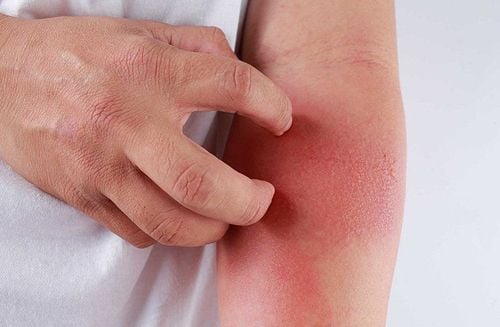This is an automatically translated article.
Latex allergy is an allergic reaction to substances in natural latex, occurs when in contact with latex gloves, condoms, ... and produces a variety of symptoms. This allergic reaction occurs when a person's immune system reacts to a protein found in the latex of natural plants.
1. What is a latex allergy?
Latex allergy is when the immune system overreacts to certain proteins found in natural latex used to make latex gloves, condoms, and some medical devices. Repeated exposure to rubber and rubber products may be part of what makes it happen.
Between 30% and 50% of people with a latex allergy also have a reaction to eating, touching, or even smelling certain foods. This happens because some fruits and vegetables have proteins that are structurally very similar to the proteins that cause a reaction to the latex. These foods include: avocados, bananas, celery, melons, potatoes, tomatoes, etc. A latex allergy can get worse the more you are exposed to it. If you know you have this condition, be aware of potentially reactive products. Some household items made of rubber include:
Rubber sink stoppers and sink mats Rubber utensils or handles Rubber rubber cords or faucets Bathroom rugs and rugs rubber pads Toothbrushes with rubber grips or handles Latex bath toys Tampons (contains rubber) Condoms and diaphragms Diapers containing rubber Adult bras containing rubber Waterproof bed sheets containing rubber Bras, socks and other clothing with elastic bands contain rubber Adhesives such as glue, glue, art supplies, glue pens Older Barbie dolls and other rubber dolls Rubber bands, mouse and keyboard cords, furniture pads, rubber stamps Mouse and wrist pads contain rubber Keyboards and computers with rubber keys or switches Pens comfortable grip or any rubber coating Remote control for TVs or recorders with rubber grips or keys Camera, telescope or binocular eyepiece Shower cap and elastic in the suit Bathing Tights grocery store checkouts Restaurants where workers use rubber gloves to prepare food Some balloons Car races have rubber tires and beads ATM buttons made of rubber

Bao cao su là một trong các vật dụng gây dị ứng cao su cho người bệnh
Latex-containing medical products include:
Tourniquets Blood pressure patches Electronic pads Some adhesive tapes Dental equipment MORE: Why are condoms allergic? What are the symptoms of a condom allergy?
2. Symptoms of latex allergy
Symptoms of latex allergy are divided into 3 levels corresponding to 3 types of latex reactions:
Irritable contact dermatitis: This is the least threatening type and it is not an allergic skin reaction. It usually occurs from repeated exposure to the chemicals in latex gloves and leads to dryness, itching, burning, scaling, and skin problems. This usually begins 12-24 hours after exposure. Allergic contact dermatitis: This is a delayed response to additives used in latex processing. It leads to irritant contact dermatitis-like reactions. However, the reaction is more severe, spreads to many parts of the body, and lasts longer. Symptoms can begin 1 to 4 days after you come into contact with the pus. Immediate allergic reaction (hypersensitivity to latex): This is one of the most serious reactions. It can manifest when we have a nasal allergy with hay fever-like symptoms, conjunctivitis (pink eye), cramps, rash and intense itching. Rare, but symptoms can also include heart palpitations, tremors, chest pain, shortness of breath, low blood pressure, or anaphylaxis. This is a serious and potentially life-threatening allergic reaction.
3. Who is at risk of latex allergy?
Approximately 5% to 10% of healthcare workers suffer from some form of latex allergy. Other people who are more likely than most to have it include:
Having a defect in their bone marrow cells Deformed bladder or urinary tract Having more than one operation Catheters rubber-tipped urine Allergies, asthma or eczema .

Người có bệnh lý hen suyễn có nguy cơ dị ứng latex
Through the skin: eg when you wear rubber gloves Through mucous membranes: eg eyes, mouth, vagina and rectum By inhalation: Gloves Latex may contain cornstarch, which absorbs and can become airborne when gloves are removed. Through blood: This can happen when some medical devices that contain rubber are used.
4. Diagnosis of latex allergy
Diagnosis of latex allergy is based on symptoms of an allergic reaction such as skin rash, hives, tearing or irritated eyes, wheezing, itching, difficulty breathing when exposed to latex or a natural rubber product.
In addition, the risk of developing a latex allergy can be assessed with blood or skin tests that will show they have it, even if there are no symptoms yet. If you need a skin test to check for a latex allergy, an allergist must supervise it, in case you have a serious reaction.
5. Treatment of latex allergy
Currently, there is no specific treatment for latex allergy. If you are allergic to latex, it is best to avoid contact with it. If there is a reaction after exposure, treatment will depend on the severity. For irritated skin, some treatment drugs will be used such as:
Antihistamines Corticosteroids If the reaction is severe, epinephrine and some intravenous solutions can be used. If you are allergic to latex, you will need to wear a medical alert bracelet or other type of emergency ID upon admission. Tell them about your latex allergy at least 24 hours before your appointment. The hospital or doctor's office should have a plan in place so that they can use products such as nonlatex gloves to treat sick people.
In a nutshell, a latex allergy occurs when the immune system overreacts to certain proteins found in natural latex used to make latex gloves, condoms, and certain devices medical. Latex allergic reactions can cause mild to severe symptoms. Therefore, to prevent latex allergy, you should limit your contact with objects made from rubber. When you have symptoms of an allergic reaction, go to the facility immediately for timely treatment.
Please dial HOTLINE for more information or register for an appointment HERE. Download MyVinmec app to make appointments faster and to manage your bookings easily.
Reference sources: healthline.com, webmd.com












